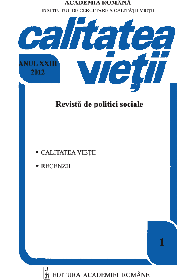Utilizarea simulării stocastice Monte Carlo pentru determinarea fluctuaţiilor minimului de trai decent într-o populaţie dată
The utilization of Monte Carlo stochastic simulation to determine the decent minimum standard of living’s fluctuations, in a given population
Author(s): Stefan Stefanescu, Adina MihăilescuSubject(s): Social Sciences
Published by: Editura Academiei Române
Keywords: Monte Carlo simulation; normative method; the minimum decent living; relationships between revenue and expenditure
Summary/Abstract: By normative method we can evaluate, for example, the minimum income needed for a decent living in a given subpopulation data. The level of w is calculated taking into account various types of expenses. Usually, in the literature, this approach is a so-called determinist one, the expenses being interpreted as constants, which the calculation method will be described below. In reality, the expenses cj fluctuate within certain limits, following various types of distributions, with respect to the assumptions made. In this approach, the level is actually a random variable which distribution we intend to estimate. In the following, we suggest a methodology based on the stochastic Monte Carlo simulation in order to determine the empirical distribution of random w values. There were, thus, proposed several hypotheses concerning the shape of the expenses, cj distribution, as well as the possible relations between these expenses. In fact, the expenditures of the studied population, which is below a given threshold value, show the percentage of the analyzed population which find itself in a poverty situation, or otherwise, “falls into poverty”. For example, 12% of individuals, about the entire first decile (option VI) (Table 3.4), shows that the segment of the population which spends more than 1 850 lei falls into poverty, and at a threshold of 1 882 lei, 25% of individuals, about the first quartile, enters poverty if this threshold is exceeded. The actual value of an indicator is not very often useful in practice, if there isn’t also considered a view upon the variations of the coefficient. Thus, the value of an index once obtained, we will find the estimation using the stochastic simulation Monte Carlo, while respecting the constraints imposed by the problem, and the range of variation of the indicator. This work method was also applied for the case of the normative method of minimum income evaluation, namely, the necessary income for a decent living of a two members family with two children, living in an urban area. W is determined taking into account different types (cj) of expenses. Usually in literature, cj are deterministic, being considered as constants. This approach however, doesn’t takes into account the fluctuations of the expenses, fluctuations which are often specific to a given actual situation. This new approach states that w was not a determinist constant, being rather a fluctuating variable w which statistical characteristics are estimated. We suggested here a method based on the statistical simulation Monte Carlo, with the intention to finally determine (establish) the empirical repartition of w values. Thus, several work variants were proposed with respect to the statistical repartition of cj expenses (SV1 and SV2 politics), being, at the same time, possible to impose some sort of interdependence among the types of expenses. The statistical simulation used for the evaluation of the decent minimum standard of living implied specific work
Journal: Calitatea vieţii
- Issue Year: XXIII/2012
- Issue No: 4
- Page Range: 327-344
- Page Count: 18
- Language: Romanian

